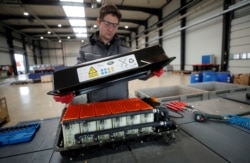Critics of electric vehicles say they do reduce carbon emissions, but the process of making the materials for their batteries produces large amounts of carbon.
Now, researchers in Britain and the United States have found ways to reuse old electric vehicle batteries. The methods can cut costs and carbon emissions while providing supplies for an expected increase in demand. The methods involve taking out parts of the battery so they can be reused.
National governments are looking for ways to get the minerals needed for vehicle batteries because they expect a strong increase in demand for electric vehicles.
The new reuse methods could provide a greater supply of valuable materials such as cobalt and nickel. They would also reduce dependence on China and other places where mining operations may be difficult.
Batteries are unlike other metal products
Gavin Harper is a researcher at the government-backed Faraday Institution in Britain. He said, "We can't recycle complex products like batteries the way we recycle other metals. Shredding, mixing up the components of a battery and pyrometallurgy destroy value."
Pyrometallurgy refers to the removal of metals using high heat. Current recycling methods also rely on shredding, or cutting the batteries into very small pieces, known as black mass. Then the pieces are processed into metals such as cobalt and nickel.
Analysts say this method for recycling is wasteful.
The scientists working on the problem say it would be less costly and use less energy to do direct recycling. That method holds onto electrical parts such as the cathode and anode.
Researchers from the University of Leicester and the University of Birmingham are working on the Faraday Institution's ReLib project. They have found a way to use ultrasonic waves to recycle the cathode and anode without shredding. They have applied for a patent, government protection of their method.
In making the battery, a powder made up of cobalt, nickel and manganese is placed on an aluminum sheet. Another metal powder, which would typically be graphite on a copper sheet, makes up the anode. The new technology recovers these metal powders.
Andy Abbott is a professor of physical chemistry at the University of Leicester. He said separation using ultrasonic waves would result in cost savings of 60 percent compared with the cost of unused material.
Abbott compared the new ultrasonic technology with current technology based on hydrometallurgy, which uses liquids such as sulphuric acid and water to remove materials. He said ultrasonic technology can process 100 times more battery material over the same period.
Abbott's team has separated battery cells by hand to test the process. ReLib is working on a project to use robots to separate batteries and packs more efficiently.
It takes time to get enough supplies from recycling, Abbot said. So, he thought the technology would probably begin by including extra material from battery manufacturing facilities.
Making money from recycling
In the United States, another a government-sponsored project called ReCell is in progress at the Department of Energy. ReCell is demonstrating different, but also promising, recycling technologies that renew battery cathode to make it into new cathode.
ReCell is headed by Jeff Spangenberger. The group has studied many different methods, including ultrasonics, but focused on heat and liquid based methods.
Spangenberger explained that the U.S. does not make much cathode. “So if we use hydrometallurgy or pyrometallurgy we have to send the recycled materials to other countries to be turned into cathode and shipped back to us," he said.
Spangenberger added that new methods that create higher profits for recyclers need to be developed "to make lithium-ion battery recycling profitable, without requiring a disposal fee to consumers, and to encourage growth in the recycling industry.”
There are some problems that direct recycling needs to overcome, including changing knowledge of chemical processes, he said. "ReCell is working on separating different cathode chemistries."
Early electric vehicle battery cells typically used a cathode with equal amounts of nickel, manganese and cobalt. Scientists use the mathematical relationship 1-1-1 to describe this mixture. This has changed in recent years as manufacturers seek to reduce costs and cathode chemistries can be 5-3-2, 6-2-2 or 8-1-1.
The approach at Faraday's ReLib project is to blend recycled with unused material to get the required ratios of nickel, manganese and cobalt.
I’m Bryan Lynn.
Pratima Desai reported on this story for Reuters. Jill Robbins adapted it for Learning English. Susan Shand was the editor.
_________________________________________________________
Words in This Story
battery – n. a device that is placed inside a machine (such as a clock, toy, or car) to supply it with electricity
emissions – n. something sent out or given off; used to describe harmful substances released into the air by automobiles or industry
recycle – v. to make something new from (something that has been used before)
cathode – n. the part of an electrical device (such as a battery) where electrons enter
anode – n. the part of an electrical device (such as a battery) from which electrons leave
shred – v. to cut or tear (something) into long, thin pieces
patent – n. an official document that gives a person or company the right to be the only one that makes or sells a product for a certain period of time
ultrasonic – adj. used to describe sounds that are too high for humans to hear
lithium – n. a soft silver-white element that is the lightest metal known; used in a rechargeable battery that uses lithium ions
disposal – n. the act of throwing something away
fee – n. an amount of money that must be paid
What do you think of this new recycling method? Have you had an experience of driving an electric car? Are they available where you live? We want to hear from you. Write to us in the Comments Section.












